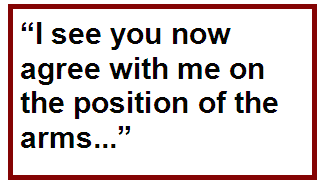 Somebody actually reads this stuff!
Somebody actually reads this stuff!
Yes I know I sound surprised, but it’s not until feedback arrives in one form or another that one realises the messages are getting through. Just as the gymnast can be inspired, encouraged and guided by appropriate feedback, I too am motivated to share some of my trampolining thoughts with you and respond to your comments and suggestions. I will restrict myself to two recent dialogues with readers. One which I feel requires more clarification on my part and the other which opens up a whole new topic.
The first arises out of my last article on the back to front connection. A long standing and admired coaching colleague approached me at the Nationals to compliment me on the article and saying “I see you now agree with me on the position of the arms.” Puzzled, I asked for clarification. “You always stated that the arms should be down on landing and now you say they should be up, which is what we used to argue about!”
The reason I quote this exchange is because it raises a number of fundamental issues, some of which I have dealt with in previous writings. Let me deal with the word “position”. During the process of coming into first contact with the bed and its subsequent depression to the bottom - what I have called “the landing phase,” there is no such thing as a “position” of the arms! The arms should be working dynamically in a rhythm which matches the speed of bed depression. They do not take up a “position” they are active in a process! That process will start with the arms following through from the form “position” displayed during the aerial phase. As first contact with the bed is made, unless the somersault is seriously overthrown, the arms will be somewhere between 6 o’clock and 9 o’clock but on the move towards the ideal finishing point at 12 o’clock when the bed is at full depression. Only now can we use the word “position”. The reference to “on landing” is inappropriate because, as I outlined in my very first Gym Craft article in March 2003, we shouldn’t talk about “landing” as an instant, but rather as the beginning of a process called the “landing phase”. You may think I am being pedantic or even picky over the use of language, but when describing movement in coaching terms we need to a) fully understand what we are talking about and b) express exactly what we mean. It is a failure to follow these two principles which has led to poor coaching and the culture of what I called “myths and misconceptions” (GymCraft Issue 12, Dec 2004).
My other reader, yes I know there are at least two, wrote to the editor about the importance of breathing patterns during trampoline performance. This topic, he pointed out, had not been covered on any course or coaching manual. He urged me to write on the subject presumably hoping I would supply some authority and offer advice to coaches.
In my emailed response to this query, I had to acknowledge that the subject receives very little attention and this could be because the process is a natural one which each gymnast deals with in their own way. I certainly never attempted to coach a particular breathing pattern and can’t remember ever having to remind the gymnast to keep breathing during a routine!
The reader’s attention had been aroused when watching a university competition as one of the better competitors was heard to breathe noisily when applying maximum power into a move. What, he wondered, was the significance of this and did it help with skilled performance, and should coaches actually be teaching a correct breathing method? What follows is simply my opinion based on years of experience in sport, coaching and performance, but certainly not an authoritative answer to the questions posed. Perhaps the topic will generate further debate among those more qualified to comment and I would welcome readers’ views.
I have noted that a small percentage of male World Class trampolinists do exhale audibly during the performance of their routines although I have not observed this with the women. A classic example is James Higgins of Northampton, the 2007 British Men’s Champion who exhales loudly with each skill performed. I have never discussed this with James or his coach but my thoughts are that his exhalation takes place to coincide with the kick out of each skill and certainly not during power application. The consequence of exhalation is of course inhalation, meaning that as he drops towards first contact he will be breathing in, I speculate that when the bed is depressing and the stresses on the gymnast are reaching at least eight times body weight, he will have arguably greater central stability as a result of full lungs. I would further speculate that there is a short period of breath holding while the full loading on the body is dealt with and effective posture maintained during the uprise of the bed. This process will result in the consequent expulsion of air being heard during the kick out element of the flight phase.
It is also possible that the audible exhalation occurs during the kick out in order to help establish the tempo of the routine. The World Class performer will attempt to replicate the tempo established during preliminary jumping as they execute the ten moves in the routine. An audible rhythmic exhalation at the same moment in each skill can be reasonably regarded as reinforcing the regular tempo required to produce World Class work. Whether the gymnast has been coached into adopting this mode of breathing is doubtful and again I would speculate that the gymnast has acquired the behaviour idiosyncratically. You will note that I have sought only to “speculate” on the significance of an audible breathing pattern as I am unaware of any studies dealing with the topic. Clearly this could be an interesting area for research and I look for some Sports Science academic to take up the challenge. We know that it has become accepted practice for some high profile tennis players, athletes in the throwing events and karate exponents, to use a powerful, audible exhalation following the application of force. It is, I believe deemed to enhance the ability to release maximum power in the shot, throw or punch, but I would contend that in trampolining the phenomenon is different due to the nature of the moving base upon which the athlete has to perform. So there you are, more questions than answers, and for once, a refusal on my part to pontificate on the subject. I am grateful to my correspondent for opening up the debate and I look forward to the views of my fellow coaches and perhaps the adoption of the subject by some academic who has the time and motivation to delve into the subject.
I started writing these articles with the missionary zeal of someone determined to pass on their acquired knowledge and the hope of making a difference. I am so grateful that my words are indeed read, if not always fully understood (my fault?) and that you respond, sometimes with appreciation, but always in a way that tells me l have made you think.
© Jack Kelly
 ®
®









